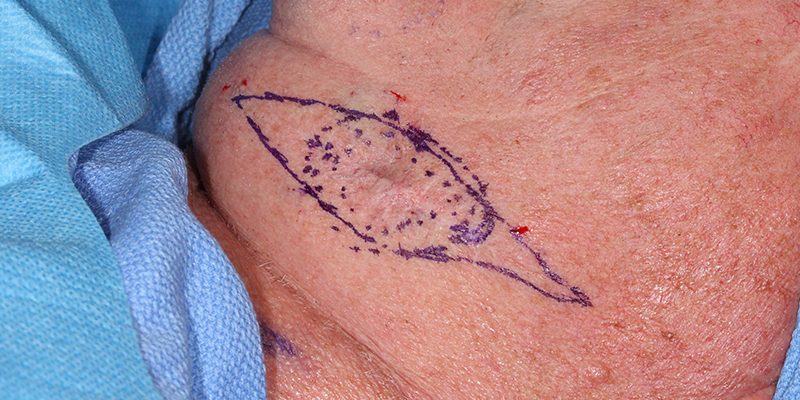
Metatypical basal cell carcinoma is also referred to as basosquamous cell carcinoma. This is a dangerous and a rare form of skin cancer. The disease process is more aggressive, likely to recur, and prone to metastases. While the likelihood of developing this type of skin cancer increases on areas of the body that have had years of sun exposure, metatypical basal cell carcinoma might also form on non-exposed regions. Early detection and treatment is vitally important.
Signs of Metatypical Basal Cell Carcinoma
Metatypical Basal Cell Carcinoma is a unique form of skin cancer, in that multiple combinations of cells are found within the actual malignancy. Because of this, lesions may vary in size and appearance. There are no specific features to determine whether a lesion is a metatypical basal cell carcinoma or another kind of basal cell carcinoma. The diagnosis is made after biopsy.
Some of the most common physical characteristics of metatypical basal cell carcinoma are noted as:
- Lesions ranging in size from 1/8 inch (0.4 centimeters) to nearly 2 inches (5 centimeters)
- Raised and slightly reddened, pimple-like growths
- Irregularly shaped flattened patches of skin
Essentially, anything that appears as a red bump, rash or scab-like marking (whether raised or flat), should be checked, especially if it stays for over a period of 3 weeks or recurs (comes and goes).
Please keep in mind, there are certain risk factors to be aware of when trying to spot a metatypical basal cell carcinoma. They are:
- Prolonged sun exposure, skin with years of sun damage
- Having fair skin
- Age - metatypical basal cell carcinoma is more likely to develop in patients over 65
- Gender - In people over 65 years old, men are nearly twice as likely to develop the cancer
- A person who has had a previous skin cancer may be at higher risk
Diagnosis And Treatment
If your dermatologists suspects this skin cancer, the first step will be to order a biopsy. If metatypical basal cell carcinoma is present, complete removal of the lesion is necessary.
Mohs micrographic surgery performed by a board certified surgeon is one of the most effective means of ensuring complete tumor removal. The method was developed by and named for Dr. Frederick Mohs in the 1930s. The treatment involves removing the abnormal cells from the mass one layer at a time. Each layer is then immediately examined under a microscope.
A laboratory technician prepares the specimen by cutting, mapping and staining the cells. The layer then undergoes freezing and further shaving into extremely thin slices. The technique enables surgeons to more effectively identify the margins of the mass (the area where the skin cancer stops). Surgeons repeat the process until specimens no longer contain malignant cells.
The benefits of Mohs surgery include knowing that the entire mass is successfully eliminated while not having to wait for a lab report outside of the treatment facility. Mohs surgery also preserves a greater amount of healthy skin, and has been shown to greatly decrease the return rate of metatypical basal cell carcinomas
Prevention and Detection
Prevention
There are certain precautions that can be taken to protect the skin against damage from over exposure to UV rays. They include, avoiding peak hours in the sun, covering up with a sun hat or protective clothing, and applying sunblock regularly - every two hours throughout the day if you plan to be outside.
Since metatypical basal cell carcinoma can form on areas of the skin that are not exposed, the next best form of prevention is to be aware of your body and the warning signs of skin cancer. This will help you spot a new lesion relatively quickly if one happens to occur.
Detection
Early detection can save your life when it comes to this very rare and dangerous skin cancer. Remember, metatypical basal cell carcinoma will look similar to other forms of skin cancer until it is examined under a microscope.
Practice your at home monthly skin checks, maintain a diligent schedule with your dermatologist for professional skin exams, and know the warning signs of skin cancer. If you spot anything suspicious, schedule an appointment with a dermatologist immediately.
Need a skin check?
Contact us today to schedule a skin check with one of our skin cancer specialists
Stay up to date
Receive research updates, inspiring stories, healthy living tips and more.
WHY CHOOSE SCARS CENTER?
SCARS Center is home to some of the most widely respected dermatologists and plastic and reconstructive surgeons in Orange County.
FOLLOW US
STAY UP TO DATE
Receive research updates, inspiring stories, healthy living tips and more.
Orange County's Premier Skin Cancer Treatment Center
